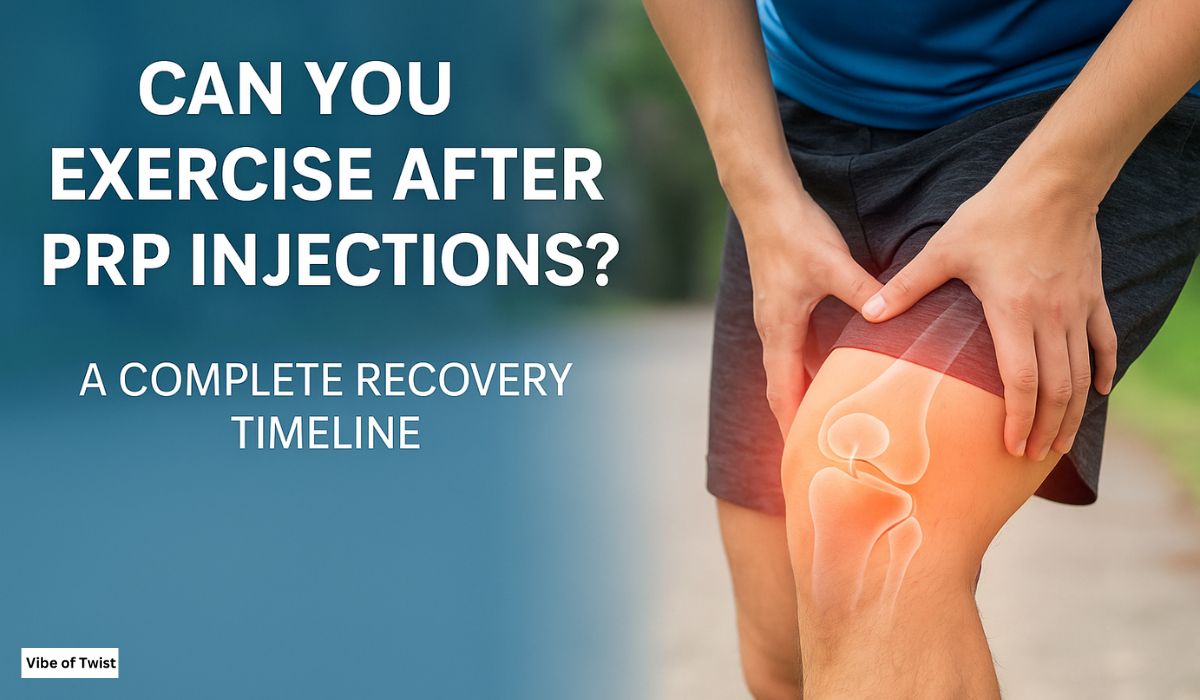
Can You Exercise After PRP Injections? A Complete Recovery & Exercise Timeline
Can you exercise after PRP injections? This is one of the most common questions people ask after receiving platelet-rich plasma injection therapy. PRP is a breakthrough treatment used for joint healing therapy, sports injuries, and conditions like arthritis. While the injection itself only takes about an hour, the PRP treatment recovery process is much longer. And yes, it affects how and when you can move again.
This article gives you the full picture. You’ll learn exactly how long to wait to exercise after PRP injection, which activities are safe, and how to avoid setbacks. The PRP recovery timeline is different for everyone, but the key to success is knowing what your body needs at each step.
Let’s dive into the science and real-life recovery phases of orthopedic PRP treatment, so you can get back on your feet safely and confidently.
What is PRP Treatment?
Platelet-rich plasma injection is a non-surgical outpatient therapy used to promote healing in damaged joints, tendons, and muscles. Doctors take a small amount of your blood, spin it in a machine to separate the platelets, then inject that rich plasma into the injured area. The platelets are full of growth factors that speed up the body’s repair process.
PRP therapy for joints is popular with athletes and older adults. It’s used to treat issues like tennis elbow, knee arthritis, rotator cuff injuries, and more. Most patients need one to three injections over a few weeks. Although the procedure is quick, recovery takes time. That’s where PRP injection aftercare and understanding the PRP recovery phases become critical.
Why Exercise Matters After PRP Therapy
After getting a PRP shot, many patients wonder: How long after PRP can I exercise? The answer is not right away. Your joint needs time to absorb the platelets and start healing. Early movement can damage the tissue further and weaken the benefits of the injection.
However, physical activity is still important later on. It helps you rebuild strength, restore flexibility, and improve balance. Once the post-PRP care period is over, exercise becomes a tool for full recovery. But there are exercise restrictions after PRP you must follow carefully. That’s why it’s important to plan your PRP and workout schedule with professional advice.
Post-PRP Injection Recovery Timeline
The PRP recovery timeline typically lasts 6 to 8 weeks, broken into four stages. Knowing what to do (and what not to do) during each stage is key to long-term healing.
Phase 1: Day 0 to Day 3
This is the rest phase. Most doctors recommend avoiding all movement of the injected area for the first 72 hours. You might wear a sling, boot, or brace, depending on the joint treated. Applying ice and elevating the area may help reduce swelling. Why no exercise after PRP at this point? Because the platelets need to bind to the injured tissue undisturbed.
Phase 2: Day 4 to Day 14
You can begin light exercises after PRP, but only if your doctor approves. This may include gentle walking, light stretching, or using a stationary bike with no resistance. It’s still too soon for cardio or weight training. Think of this phase as the foundation of your recovery. Push too hard, and you risk setbacks.
| Day | Activity | Notes |
| 1-3 | Total Rest | No exercise, brace support |
| 4-7 | Gentle Walking | Max 5-10 mins at a time |
| 8-14 | Light Stretching | Range of motion exercises only |
What Exercises Are Safe After PRP Injections?
In weeks 3 to 6, you can slowly increase your activity level. This is where safe return to fitness post-PRP begins. Most patients are allowed to do yoga, swimming, or resistance band exercises. These help improve mobility after PRP without placing too much stress on healing tissue.
During this time, avoid jumping, sprinting, or lifting weights. These are still exercises to avoid after PRP injections. Stick to safe exercises after PRP therapy that don’t cause pain. If you feel discomfort that lasts more than 24 hours, scale back.
Week 3 to 6 Approved Movements
| Type of Exercise | Safe or Unsafe? |
| Walking (flat surface) | Safe |
| Light swimming | Safe |
| Yoga (non-weight bearing) | Safe |
| Jogging | Unsafe |
| Weight lifting | Unsafe |
Working With a Physical Therapist
Physical therapy after PRP makes a big difference. A licensed therapist will create a personalized plan based on your injury, age, and fitness level. They’ll guide you through rehabilitation after PRP, checking for signs of progress or pain.
Working with a PT is one of the best recovery practices after PRP. They can also help prevent complications after PRP, like scar tissue buildup or joint stiffness. A therapist also knows exactly when to resume exercise after PRP, so you’re not guessing. For those aiming at returning to sports after PRP, therapy is a must.
Final Tips for a Safe and Speedy Recovery
Healing takes time. Most people can expect full PRP therapy results in about 8 to 12 weeks. For athletes, returning to gym after PRP may take longer. Even when you feel fine, your body might still be repairing beneath the surface. That’s why following post PRP care instructions is crucial.
Here are some final tips:
Stay hydrated and eat foods rich in protein and vitamin C. These nutrients support tissue repair. Avoid anti-inflammatory medications unless your doctor says otherwise—they can interfere with platelet activity. Keep all follow-up appointments. Communicate honestly with your doctor or therapist if you feel unusual pain.
You may ask: Is walking okay after PRP injection? Yes, but start slow. What about running? That depends. When can I run after PRP? Usually around week 8, but only with medical approval. Recovery isn’t a race. Take it day by day.
And finally, how long does PRP take to work? Most patients feel the difference around week 4, with full improvement by week 12. But every person is unique. With the right balance of rest and motion, you’ll heal stronger than ever.
Conclusion:
If you’ve been wondering how long to wait to exercise after PRP injection, now you have the answer—and a roadmap. Be patient, follow the PRP treatment activity limitations, and trust the process. With the right care, your healing after PRP injections will be successful, and you’ll be back to your active life sooner than you think.
Stay safe, listen to your body, and keep moving—at the right pace.
FAQs
1.How soon can you exercise after a PRP injection?
Wait at least 2 weeks before light exercise and 4–6 weeks for intense workouts, with your doctor’s approval.
2.How can I maximize my PRP results?
Follow post-PRP care, avoid NSAIDs, rest properly, hydrate well, and work with a physical therapist.
3.How long does it take for PRP to absorb?
PRP begins working within days, but full healing can take 4–6 weeks or more depending on the injury.
4.What should I avoid after a PRP injection?
Avoid intense exercise, anti-inflammatory meds, alcohol, smoking, and massage or heat therapy.
5.Why no caffeine after PRP?
Caffeine may reduce blood flow and slow healing, so it’s best to limit it in the first few days.
6.What vitamins to avoid after PRP?
Avoid Vitamin E, fish oil, turmeric, and garlic supplements as they can interfere with platelet function
